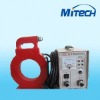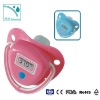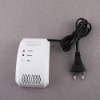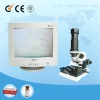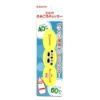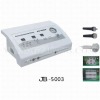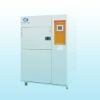CDX-III Multi-functional Magnetic Particle Detector
I. Brief Description
CDX-III magnetic-particle detector is a new type magnetic particle fault localization equipment designed and produced by our Company independently . Magnetization by additional magnetic field renders the detector small in size and light in weight. Highly integrated circuit makes one device perform all the functions of several one.
Selection of function:
A type probe: also named horseshoe magnetic yoke probe or fillet weld probe, turning joint angular magnetic head, which is fitted with a working lamp and is especially suitable for fault detection of work pieces with abnormal face and complicated shape. Polar distance: 20-160mm;lifting power: AC≥kg,DC≥18kg;weight :1kg. The equipment made by using this probe is referred to as horseshoe magnetic yoke detector or fillet weld detector. The probe finds wide application as it uses the turning joint.
D type probe: also called electromagnetic yoke probe with various turning joints and great magnetization strength. Polar distance:60-220mm; lifting power: AC≥7kg,DC≥18kg; weight: 1.6kg.The equipment made by using this probe independently is named electromagnetic yoke detector and the probe is featured by high magnetic inductivity and great magnetization strength.
E type probe: also called cross magnetic yoke probe or rotating-field probe and can conduct omnibearing combination magnetization flaw detection at a time. The running roller and working lamp can increase the fault detection speed. Polar distance: 110mm,lifting power: AC≥9kg and weight:2kg. The equipment made by using this probe independently is called rotating-field fault detector, which uses two cross magnetic yokes and AC move-phase technology to produce a synthetic rotating field that varies with time for omnibearing combination magnetization of a work piece at a time. The fault detection is done quickly with high inspection quality.
O type probe: also called ring probe with an internal diameter of 150mm and center field ≥180Oe.Weight:3kg.The equipment made by using this probe independently is named ring fault detector. It is designed on the principle of forming a strong magnetic field by energizing a coil and is suitable for sectional fault detection or demangnetization of complicated work pieces including axles, bars, pipes and vanes.
II. Technical performance
1. Power source: AC 220V ±10% 50HZ 5A
2. Output: AC 36V 10A Probes of A.D.E.O can be selected for fitting.
3. Fault detection speed: ≥6 m/ m
4. Temperature rise of probe: ≤60°C
5. Operating beat: It is suggested that in continuous long-time operation magnetization time ≤3 s and off time≥5 s
6. Weight of the detector: ~6.6Kg
III. Operation and maintenance
1. Operating procedure
(1) The power plug cord is connected to the socket of the instrument and the probe is
connected to the output socket properly.
(2) When external power is switched on, the indicator lamp will flash, the control circuit
will also be closed and the servo begins to work.
(3) With good contact of the probe with the work piece to be detected, the switch on the
probe is pressed. Then the work piece will be magnetized by the instrument with the work lamp flashing. When the switch is released, the main loop power will be cut off and the work piece won’t be magnetized.
(4) If the detector is not in use, the switch should be turned off to cut off the power.
2. Trouble shooting
(1) For no indication of energization, non-operation or blown fuse, short circuit or
overload may be the cause.
(2) The probe works after the switch is pressed, but no work indication is seen. The
indicator lamp is out of order.
(3) The indicator lamp is on, but the probe doesn’t magnetize. The main circuit or control
circuit fails.
(4) If power is switched on, magnetism is charged without pressing the switch. The
control circuit or bilateral silicon-controlled switch may be broken.
Compatible probe
Power input indicator
Dust proof design
Good heat dispersion
Metal handle
Power interface
Package in case
Packing case
